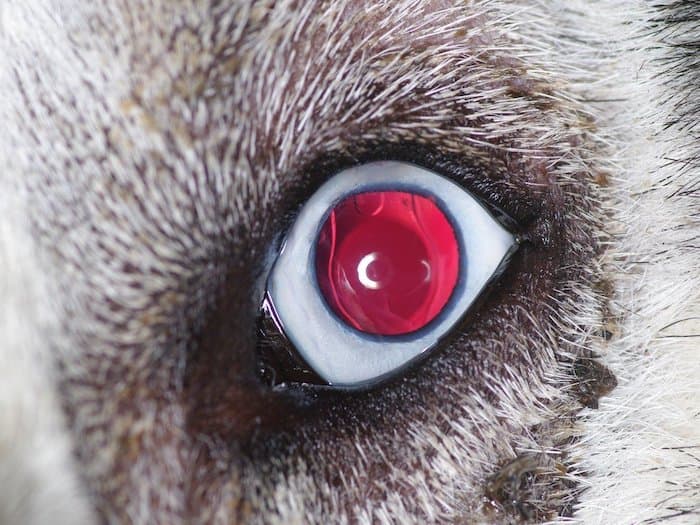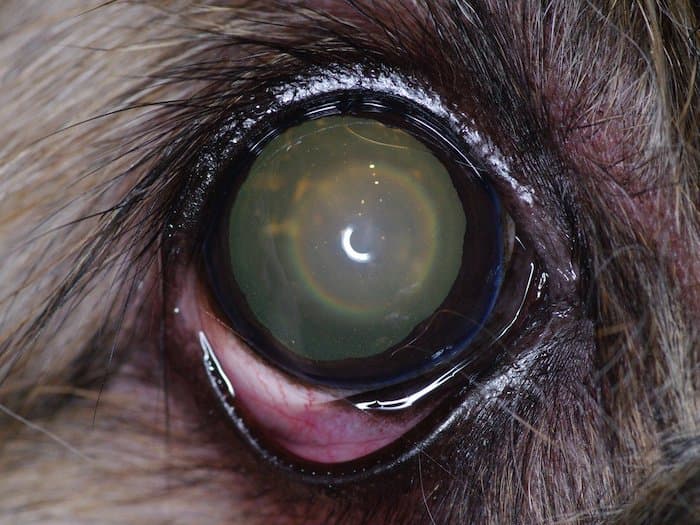Cataract is a common cause of vision loss in dogs. It also occurs in cats and other species. When a cataract develops, the lens of the eye becomes opaque or cloudy, meaning that light cannot pass through the eye normally.
How does light pass through the eye?
In a normal healthy eye, light enters through the cornea at the front, passes through the clear lens, and is then focused on the retina at the back. Nerve impulses from the retina then pass the visual information on to the brain.
Animation showing the mechanism of light transmission through the lens:
If a cataract develops and the lens becomes cloudy, this interferes with the passage of light. Some cataracts are small and mild, but more advanced cataracts can make the lens almost completely white. When cataracts are this severe, light cannot pass through at all and this means that the eye is blind.
Picture of a dog with a cataract:

What are the causes of cataracts?
Dogs might develop cataracts for the following reasons:
- Some breeds of dog are genetically predisposed to develop cataracts. These 'hereditary cataracts' typically develop in both eyes. Occasionally the cataracts can be present at birth, but more often they develop in adult dogs.
- Just like humans, dogs and cats can develop age-related cataracts when they are elderly.
- Diabetes is another cause. In this condition, the high sugar levels in the lens cause metabolic changes that make the lens become cloudy.
- Injury to the eye is another potential cause.
- Other causes include poisoning, a deficiency of certain nutrients, or eye diseases such as glaucoma or retinal diseases.
What are the signs of cataracts?
Unless the cataract develops as a result of injury or another eye disease with obvious symptoms, the first sign you will normally see is a cloudiness or whiteness of the eye. However, cloudiness in an older dog's eyes is not always due to cataracts. In older dogs, the lens of the eye may become a bluish or grayish colour due to a condition called 'nuclear sclerosis', which is part of the normal ageing process. In nuclear sclerosis, dogs do not lose their vision and no treatment is needed.
Animation showing the light transmission in case of nuclear sclerosis:
Picture of a dog with nuclear sclerosis:

Your vet will be able to distinguish between nuclear sclerosis and cataracts by assessing your dog’s vision and examining their eyes with an instrument called an ophthalmoscope. If your vet finds that cataracts are present and they suspect an underlying cause such as eye disease or diabetes, they may suggest other tests as well.
How will I know if my pet is struggling to see?
The degree to which your pet's vision is affected will depend on the size and maturity of the cataract. It is not always easy to spot when dogs are losing their sight though: when vision loss develops over a period of time, dogs, but also cats, are generally able to use their good hearing and sense of smell to adapt well. The following signs might be a clue that your pet is losing their vision:
- If they have problems getting around your home if you move furniture away from its normal position
- If they seem to be having difficulty finding their way round an unfamiliar environment
- If they do not notice a small and light object (e.g. ball of cotton wool) being dropped noiselessly in front of their nose.
Can cataracts be treated?
It is possible to treat cataracts surgically, but especially in elderly pets, it is important to balance the risk of the anaesthetic against the benefits of surgery. The presence of other eye conditions or complications may also affect the decision for surgical treatment. Your vet will be able to advise on whether this is a good option for your pet.
Cataract surgery in dogs is usually performed using a technique called phacoemulsification. In this process the lens is broken up with ultrasonic waves and then removed and replaced with an artificial lens.
Animation showing the principle of phacoemulsification to remove a cataract:
While phacoemulsification is the most common process, different surgical techniques may be used if there are other problems with the eye. If your dog or cat has cataracts in both eyes, your vet may recommend removing both at the same time so that your pet only has to go through one anaesthetic.
After surgery, it is important to follow veterinary guidance as regards aftercare. Regular eye drops may be needed long-term as advised by your vet.
Animations ©Medi-Productions


